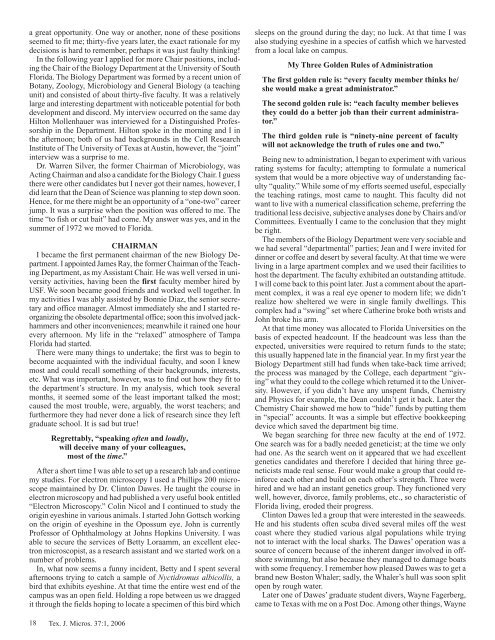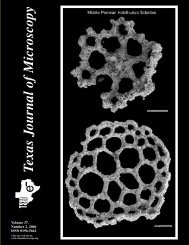Texas Journal of Microscopy Texas Journal of Microscopy
Texas Journal of Microscopy Texas Journal of Microscopy
Texas Journal of Microscopy Texas Journal of Microscopy
Create successful ePaper yourself
Turn your PDF publications into a flip-book with our unique Google optimized e-Paper software.
a great opportunity. One way or another, none <strong>of</strong> these positions<br />
seemed to fit me; thirty-five years later, the exact rationale for my<br />
decisions is hard to remember, perhaps it was just faulty thinking!<br />
In the following year I applied for more Chair positions, including<br />
the Chair <strong>of</strong> the Biology Department at the University <strong>of</strong> South<br />
Florida. The Biology Department was formed by a recent union <strong>of</strong><br />
Botany, Zoology, Microbiology and General Biology (a teaching<br />
unit) and consisted <strong>of</strong> about thirty-five faculty. It was a relatively<br />
large and interesting department with noticeable potential for both<br />
development and discord. My interview occurred on the same day<br />
Hilton Mollenhauer was interviewed for a Distinguished Pr<strong>of</strong>essorship<br />
in the Department. Hilton spoke in the morning and I in<br />
the afternoon; both <strong>of</strong> us had backgrounds in the Cell Research<br />
Institute <strong>of</strong> The University <strong>of</strong> <strong>Texas</strong> at Austin, however, the “joint”<br />
interview was a surprise to me.<br />
Dr. Warren Silver, the former Chairman <strong>of</strong> Microbiology, was<br />
Acting Chairman and also a candidate for the Biology Chair. I guess<br />
there were other candidates but I never got their names, however, I<br />
did learn that the Dean <strong>of</strong> Science was planning to step down soon.<br />
Hence, for me there might be an opportunity <strong>of</strong> a “one-two” career<br />
jump. It was a surprise when the position was <strong>of</strong>fered to me. The<br />
time “to fish or cut bait” had come. My answer was yes, and in the<br />
summer <strong>of</strong> 1972 we moved to Florida.<br />
CHAIRMAN<br />
I became the first permanent chairman <strong>of</strong> the new Biology Department.<br />
I appointed James Ray, the former Chairman <strong>of</strong> the Teaching<br />
Department, as my Assistant Chair. He was well versed in university<br />
activities, having been the first faculty member hired by<br />
USF. We soon became good friends and worked well together. In<br />
my activities I was ably assisted by Bonnie Diaz, the senior secretary<br />
and <strong>of</strong>fice manager. Almost immediately she and I started reorganizing<br />
the obsolete departmental <strong>of</strong>fice; soon this involved jackhammers<br />
and other inconveniences; meanwhile it rained one hour<br />
every afternoon. My life in the “relaxed” atmosphere <strong>of</strong> Tampa<br />
Florida had started.<br />
There were many things to undertake; the first was to begin to<br />
become acquainted with the individual faculty, and soon I knew<br />
most and could recall something <strong>of</strong> their backgrounds, interests,<br />
etc. What was important, however, was to find out how they fit to<br />
the department’s structure. In my analysis, which took several<br />
months, it seemed some <strong>of</strong> the least important talked the most;<br />
caused the most trouble, were, arguably, the worst teachers; and<br />
furthermore they had never done a lick <strong>of</strong> research since they left<br />
graduate school. It is sad but true!<br />
Regrettably, “speaking <strong>of</strong>ten and loudly,<br />
will deceive many <strong>of</strong> your colleagues,<br />
most <strong>of</strong> the time.”<br />
After a short time I was able to set up a research lab and continue<br />
my studies. For electron microscopy I used a Phillips 200 microscope<br />
maintained by Dr. Clinton Dawes. He taught the course in<br />
electron microscopy and had published a very useful book entitled<br />
“Electron <strong>Microscopy</strong>.” Colin Nicol and I continued to study the<br />
origin eyeshine in various animals. I started John Gottsch working<br />
on the origin <strong>of</strong> eyeshine in the Opossum eye. John is currently<br />
Pr<strong>of</strong>essor <strong>of</strong> Ophthalmology at Johns Hopkins University. I was<br />
able to secure the services <strong>of</strong> Betty Loraamm, an excellent electron<br />
microscopist, as a research assistant and we started work on a<br />
number <strong>of</strong> problems.<br />
In, what now seems a funny incident, Betty and I spent several<br />
afternoons trying to catch a sample <strong>of</strong> Nyctidromus albicollis, a<br />
bird that exhibits eyeshine. At that time the entire west end <strong>of</strong> the<br />
campus was an open field. Holding a rope between us we dragged<br />
it through the fields hoping to locate a specimen <strong>of</strong> this bird which<br />
18 Tex. J. Micros. 37:1, 2006<br />
sleeps on the ground during the day; no luck. At that time I was<br />
also studying eyeshine in a species <strong>of</strong> catfish which we harvested<br />
from a local lake on campus.<br />
My Three Golden Rules <strong>of</strong> Administration<br />
The first golden rule is: “every faculty member thinks he/<br />
she would make a great administrator.”<br />
The second golden rule is: “each faculty member believes<br />
they could do a better job than their current administrator.”<br />
The third golden rule is “ninety-nine percent <strong>of</strong> faculty<br />
will not acknowledge the truth <strong>of</strong> rules one and two.”<br />
Being new to administration, I began to experiment with various<br />
rating systems for faculty; attempting to formulate a numerical<br />
system that would be a more objective way <strong>of</strong> understanding faculty<br />
“quality.” While some <strong>of</strong> my efforts seemed useful, especially<br />
the teaching ratings, most came to naught. This faculty did not<br />
want to live with a numerical classification scheme, preferring the<br />
traditional less decisive, subjective analyses done by Chairs and/or<br />
Committees. Eventually I came to the conclusion that they might<br />
be right.<br />
The members <strong>of</strong> the Biology Department were very sociable and<br />
we had several “departmental” parties; Jean and I were invited for<br />
dinner or c<strong>of</strong>fee and desert by several faculty. At that time we were<br />
living in a large apartment complex and we used their facilities to<br />
host the department. The faculty exhibited an outstanding attitude.<br />
I will come back to this point later. Just a comment about the apartment<br />
complex, it was a real eye opener to modern life; we didn’t<br />
realize how sheltered we were in single family dwellings. This<br />
complex had a “swing” set where Catherine broke both wrists and<br />
John broke his arm.<br />
At that time money was allocated to Florida Universities on the<br />
basis <strong>of</strong> expected headcount. If the headcount was less than the<br />
expected, universities were required to return funds to the state;<br />
this usually happened late in the financial year. In my first year the<br />
Biology Department still had funds when take-back time arrived;<br />
the process was managed by the College, each department “giving”<br />
what they could to the college which returned it to the University.<br />
However, if you didn’t have any unspent funds, Chemistry<br />
and Physics for example, the Dean couldn’t get it back. Later the<br />
Chemistry Chair showed me how to “hide” funds by putting them<br />
in “special” accounts. It was a simple but effective bookkeeping<br />
device which saved the department big time.<br />
We began searching for three new faculty at the end <strong>of</strong> 1972.<br />
One search was for a badly needed geneticist; at the time we only<br />
had one. As the search went on it appeared that we had excellent<br />
genetics candidates and therefore I decided that hiring three geneticists<br />
made real sense. Four would make a group that could reinforce<br />
each other and build on each other’s strength. Three were<br />
hired and we had an instant genetics group. They functioned very<br />
well, however, divorce, family problems, etc., so characteristic <strong>of</strong><br />
Florida living, eroded their progress.<br />
Clinton Dawes led a group that were interested in the seaweeds.<br />
He and his students <strong>of</strong>ten scuba dived several miles <strong>of</strong>f the west<br />
coast where they studied various algal populations while trying<br />
not to interact with the local sharks. The Dawes’ operation was a<br />
source <strong>of</strong> concern because <strong>of</strong> the inherent danger involved in <strong>of</strong>fshore<br />
swimming, but also because they managed to damage boats<br />
with some frequency. I remember how pleased Dawes was to get a<br />
brand new Boston Whaler; sadly, the Whaler’s hull was soon split<br />
open by rough water.<br />
Later one <strong>of</strong> Dawes’ graduate student divers, Wayne Fagerberg,<br />
came to <strong>Texas</strong> with me on a Post Doc. Among other things, Wayne




